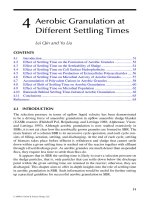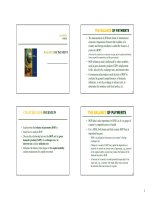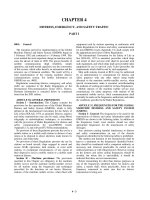Lecture Slides Chapter 4 Insulation Coordination
Bạn đang xem bản rút gọn của tài liệu. Xem và tải ngay bản đầy đủ của tài liệu tại đây (2.69 MB, 39 trang )
SEE 4463
HIGH VOLTAGE TECHNOLOGY
Dr. Nouruddeen Bashir Umar
Email:
Tel: 0177696962
Course materials
(notes, lecture slides and tutorials)
can be downloaded from:
/>
Chapter 4 :
Insulation Coordination
• When any over voltage appears in the electrical system , then there may be a
chance of failure of its insulation system.
• Probability of failure of insulation, is high at the weakest insulation point
nearest to the source of over voltage.
• Insulators in some points are easily replaceable and repairable compared to
others.
• However, at other points, the insulators are not so easily replaceable and
repairable and the replacement and repairing may be highly expensive, and
require long interruption of power.
• Therefore failure of insulator at these points may causes bigger part of
electrical network to be out of service.
• So it is desirable that in situation of insulator failure, only the easily replaceable
and repairable insulator fails.
To arrange the electrical insulation levels of different components in
the electrical system in such a manner, that the failure of insulator, if
occurs, confides to the place where it would result in the least damage
of the system, easy to repair and replace, and results least disturbance
to the power supply.
Insulation level - An insulation strength expressed in
terms of a withstand voltage
To ensure that the probability of insulation breakdown is
limited to an acceptable value and that any breakdown is
restricted to self-restoring insulation
External insulation
• Is the distances in open air or across the surfaces of solid
insulation in contact with open air that are subjected to dielectric
stress and to the effects of the atmosphere
• Example transmission line insulators
Internal Insulation
• Internal insulation is the internal solid, liquid, or gaseous parts of
the insulation of equipment that are protected by the equipment
enclosures from the effects of the atmosphere
• Example transformer and bushing insulation
Self-restoring insulation
• Insulation that completely recovers insulating properties after a
disruptive discharge (flashover) caused by the application of a
voltage is called self-restoring insulation.
• This type of insulation is generally external insulation
Non Self-restoring insulation
• This is the opposite of self-restoring insulators, insulation that
loses insulating properties or does not recover completely after a
disruptive discharge caused by the application of a voltage.
• This type of insulation is generally internal insulation
• Voltage Stress:
– Magnitude of Surge
– Duration of surge
– Distribution of stress
• Current Stress:
– Magnitude of surge
- Duration of surge
– Length of surge
• Dielectric Strength of
insulation
• Surge protective
devices
– Device characteristics
– Device placement
• Cost
1.
Selection of the reliability criteria
2.
Determination of the electrical stress placed on the equipment or the air
clearance
3.
Comparison of the insulation strength characteristic, from which a strength
is selected.
4.
If the insulation strength or the clearance is considered to be excessive,
then the stress can be reduced by use of ameliorating (improved) measures
such as surge arresters, protective gaps, shield wires and closing resistors
in the circuit breakers.
Nominal System Voltage
• Phase to phase voltage of the system for which the system is normally designed
Maximum System Voltage
• The maximum allowable power frequency voltage which can occurs may be for
long time during no load or low load condition of the power system.
Insulation Level (insulation strength)
• Lightning Impulse and short duration power frequency withstand voltage (<300 kV),
Switching Impulse (>300 kV)
Switching Impulse Waveshape
•
•
Front time:
Tail Time:
•
The standard switching impulse waveshape is 250/2500 µs
The time from the actual zero to actual crest of impulse
Time from actual zero to time to half value of tail
Basic Lightning Insulation Level (B.I.L)
•
Also known as lightning impulse withstand voltage
•
It is defined as the electrical strength of insulation expressed in terms of the crest value of the
"standard lightning impulse.“
•
In essence, the BIL is tied to a specific waveshape in addition being tied to standard atmospheric
conditions.
•
The BIL may be either a statistical BIL or a conventional BIL.
•
The statistical BIL is applicable only to self-restoring insulations, whereas the conventional BIL is
applicable to non-self-restoring insulations. BILs are universally for dry conditions
•
The statistical BIL is the crest value of standard lightning impulse for which the insulation exhibits a
90% probability of withstand, a 10% probability of failure.
•
The conventional BIL is the crest value of a standard lightning impulse for which the insulation does
not exhibit disruptive discharge when subjected to a specific number of applications of this impulse.
Fig. Statistical BIL or BSL (or statistical Impulse Withstand Voltage
Basic Switching Insulation Level (B.S.L)
•
Also known as Switching impulse withstand voltage
•
It is defined as the electrical strength of insulation expressed in terms of the crest value of the
"standard switching impulse.“
•
In essence, the BSL is tied to a specific waveshape in addition being tied to standard atmospheric
conditions.
•
The BIL may be either a statistical BSL or a conventional BSL.
•
The statistical BSL is applicable only to self-restoring insulations, whereas the conventional BIL is
applicable to non-self-restoring insulations. BSLs are universally for wet conditions
•
The statistical BSL is the crest value of standard lightning impulse for which the insulation exhibits a
90% probability of withstand, a 10% probability of failure.
•
The conventional BSL is the crest value of a standard lightning impulse for which the insulation does
not exhibit disruptive discharge when subjected to a specific number of applications of this impulse.
• For line insulation coordination, this includes transmission and
distribution lines
• The task is to specify all dimensions or characteristics of the transmission
or distribution line tower that affect the reliability of the line:
The tower strike distances or clearances between the phase conductor and the
grounded tower sides and upper truss
The insulator string length
The number and type of insulators
The need for and type of supplemental tower grounding
The location and number of overhead ground or shield wires
The phase-to-ground mid-span clearance
The phase-phase strike distance or clearance
The need for, rating, and location of line surge arresters
For station insulation coordination, similar to Line insulation coordination the
task is similar in nature.
It includes generation, transmission and distribution. It is to specify:
The equipment insulation strength, that is, the BIL and BSL of all equipment.
The phase-ground and phase-phase clearances or strike distances.
The need for, the location, the rating, and the number of surge arresters.
The need for, the location, the configuration, and the spacing of protective gaps.
The need for, the location, and the type (masts or shield wires) of substation
shielding.
The need for, the amount, and the method of achieving an improvement in lightning
performance of the line immediately adjacent to the station.
CONVENTIONAL
OR
DETERMINISTIC
METHOD
STATISTICAL
METHOD OR
PROBABILISTIC
METHOD
•
The conventional insulation coordination approach seeks the impulse
voltage level at which the equipment insulation will not show any
disruptive discharge
• This approach to insulation coordination requires the evaluation of the
highest overvoltages to which an equipment may be subjected during
operation and selection of standardized value of withstand impulse
voltage with suitable safety margin
•
Used primarily for unknown probability of failure, i.e. non-self
restoring insulations
•
The maximum amplitude of transient over voltages reaching the
components, can be limited by using protecting devices in the system
like lightning arrestor.
• To avoid insulation failure, insulation levels of different types of
equipment connected to the system have to be higher than the
magnitude of transient over voltages that will appear on the system.
• Usually insulation level is above protective level (safe margin 15 – 20%
higher)
• In a power system various equipment like transformers, circuit
breakers, bus supports etc. have different breakdown voltages and
hence the volt-time characteristics.
• Thus for proper protection of such equipment, it is therefore required
that their insulations be properly coordinated with the insulation of the
various protective devices.
• Conventional Method of Insulation Coordination involves the correlation
of the insulation of the various equipment in a power system to the
insulation of the protective devices used for the protection of those
equipment against overvoltages.









